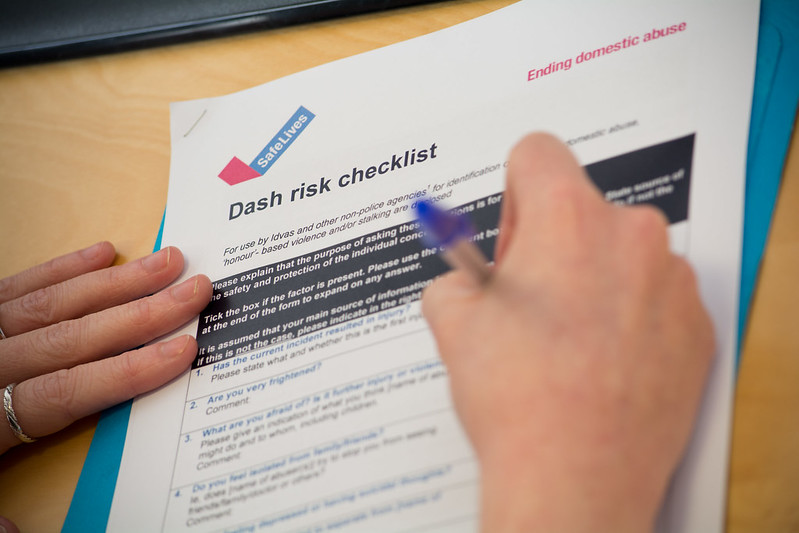
10 key practice points for supporting clients with learning disabilities
Collette Eaton-Harris is a Knowledge Hub Advisor for SafeLives. In this blog she talks to specialist practitioners about how domestic abuse workers can make their services more accessible to people with learning disabilities. She shares 10 tips that focus on making sure the client’s needs are being met, and that all applicable risks are being considered.
Studies have shown that disabled women are twice as likely to experience domestic abuse, sexual assault and rape as non-disabled women. Disabled men are also more likely to experience intimate partner violence.
Despite this, domestic abuse services may find that they rarely receive referrals for this client group. I spoke to practitioners Clare Light, a Learning Disabilities Primary Care Liaison Nurse in Somerset and Julie Reeves, a domestic abuse worker for Splitz in North Devon who has previously supported adults with learning disabilities in a residential setting, to find out what domestic abuse workers can do to make themselves more accessible to clients with learning disabilities.
Here are 10 practical tips:
- Make links with learning disability services: It is important for domestic abuse workers to proactively reach out to their local learning disabilities services which may be co-located in a health setting or a social care setting, or may be situated within a learning disabilities specific centre. Learning disabilities teams may not know about your services or how to refer to you or to the Marac; our figures show that only 7% of referrals into a domestic abuse service were received from health services, and 0% were referred through adult safeguarding. By making links you can help them better identify people at risk, but also seek their guidance on how best to support clients with learning disabilities on your case load.
- Appreciate individual needs and abilities: The individual needs and abilities of people with learning disabilities will vary hugely and so it is important to understand how to best support each client. Treating people as individuals is standard, good practice for domestic abuse workers, but clients with learning disabilities may have very specific communication needs that are not immediately apparent. As Clare Light explained; “One of our service users did not understand negatives and so would find it difficult to answer questions accurately depending on how they were phrased. This was only apparent once a speech and language therapist had assessed the client”. This has clear implications for domestic abuse practices such as conducting a Dash assessment, so it’s important to liaise with professionals who have insight into the client’s understanding of the spoken word.
- Communication is key: Because communication needs can vary, traditional ways of contacting clients e.g. by telephone or by letter may not be appropriate and could lead to clients missing out on a service. Check with the referrer and with the learning disabilities team how best to contact and communicate with the client. Some people with learning disabilities will be more familiar with the use of symbols in communication and this is something that the learning disabilities team should be able to support you with. Some clients may benefit from you using repetition.
- Include people your client knows and trusts: Clare also emphasised the importance of meeting with the client along with someone that they know and trust as this will help the client feel comfortable. Clients with learning disabilities may be particularly lacking in confidence and assertiveness. This can lead to people-pleasing which may mean that they answer your questions in the way they think is ‘right’ rather than realistic. They might minimise what is happening if they are worried that they will be in trouble or they may say yes to questions thinking that this is what you want to hear. Someone they know and trust can help manage this by preparing them for the meeting and supporting them during it. The supporter may also have important information relating to the client’s risks and needs that can feed into your assessment. Domestic abuse workers should always consider who would be a safe and appropriate person to support the client at meetings; for a number of reasons it may be that family members or friends are less suitable than a professional who has a good relationship with the client.
- Adjust your timeframes: Whilst best practice is to complete the Dash at the first opportunity, we also need to adapt our approach when the needs of the client requires a different approach. Clients with learning disabilities may not have the capacity to focus for the length of time you need to complete the Dash in one appointment. They may need to take breaks to help with focus if they become easily distracted. They may also find it difficult to retain a lot of complex information so plan to be more flexible in your approach, allowing yourself to be guided by the client and those that know them best. Always gauge the client’s understanding and help them recall by asking questions, summarising regularly and taking breaks when needed.
- Use simple examples to convey complex ideas: Coercive control is nuanced and multifaceted and whilst some behaviours are simple to identify as abusive, others are less so. This can be a challenge for someone who finds abstract concepts difficult to process. Work with the learning disabilities team to develop simple relationship ‘rules’ that the client will be able apply in order to recognise abuse. There are some good films that can support you with this; for example, this film by Bristol City Council and Misfits and this film by the Tizard Centre, University of Kent.
- Abuse may be familiarised: People with learning disabilities may have experienced poly victimisation; repeat experience of being abused throughout their lifetime. Disabled clients are more likely to be experiencing abuse from an adult family member and are more at risk of honour based violence. Our figures also show that one in five report abuse from multiple perpetrators. This means that for some clients with learning disabilities, the domestic abuse they experience may feel familiar and acceptable. They may not name what is happening as wrong. Clare explained that for some, their abuser is also their ‘rescuer’; the person who they perceive to have helped them leave an abusive family setting or who they feel protects them from abuse from other people. This may mean that they feel a sense of gratitude towards the perpetrator. Challenging the perception that the abuser is being kind and loving can be very difficult. Clare emphasises that this can lead to some clients being very reluctant to consent to a referral to a domestic abuse service. Domestic abuse workers could consider ways of making this prospect less daunting. For example, if your local learning disability service runs a day centre, you could arrange to drop in regularly to meet with potential clients more informally or jointly facilitate healthy relationship workshops for people with learning disabilities.
- Stay risk focussed: It’s important not to assume that people with learning disabilities will be receiving lots of support and will therefore have better protection from an abusive partner. Not all people with learning disabilities will need, want or have formal support services. They may be living independently or they may have family support instead. Our data suggests that disabled people are more likely than non-disabled people to be living with the perpetrator. Even if the client is living in a residential setting, this does not necessarily mean constant supervision or that they are not able to come and go from their accommodation autonomously. Our data shows that although disabled clients have a higher rate of complex needs and continue to experience a higher level of abuse at case closure compared to non-disabled clients; only 9% have engagement from adult social care. Additionally, the person who is abusing them may themselves be a service user with learning disabilities, restricting the client’s ability to access support when avoiding contact from the perpetrator. Professionals supporting the client may not be familiar with domestic abuse risk assessment or safety planning, so make sure you clearly communicate your concerns and ideas for improving safety.
- Reconsider traditional safety plan options: Clare emphasised that some of the options domestic abuse workers are used to providing would be too complex or overwhelming for many of those with learning disabilities. For example, applying for a court order or being encouraged to report breaches may not be good options for some clients. Clare also explained that despite the abuse, the client may feel a strong affection for the perpetrator and may become distressed if separated from them. This, coupled with change often being particularly frightening for people with learning disabilities, means that refuge may not be a viable option.
- Be aware of ‘Mate crime’: Mate crime is the term given to forms of hate crime in which the perpetrator(s) exploit and abuse a person with learning disabilities by presenting themselves as a friend. Perpetrators manipulate and groom to gain access to the person’s home, benefits or in order to sexually exploit. Some cases have resulted in homicide. Whilst there may not be a relationship for such crimes to be deemed domestic abuse; there are obvious overlaps, particularly as the victim may believe that the perpetrator is their boyfriend or girlfriend. Clients with learning disabilities will have the same desire and need for relationships. Julie Reeves explained that there can be a strong desire to feel accepted and to have what is perceived to be ‘normal’ experiences of relationships and sex. This, she highlights, puts people with learning disabilities at risk of being targeted and exploited by those who want to take advantage. Clients may acquiesce to requests for sexual acts because they think that they need to do this to maintain the relationship. When safety planning, domestic abuse workers should consider all the people the client is at risk from.
Collette Eaton-Harris, Knowledge Hub Advisor.
With thanks to Clare Light, Learning Disabilities Primary Care Liaison Nurse, Somerset Partnership and Julie Reeves, Splitz North Devon.
You may be interested in


